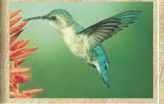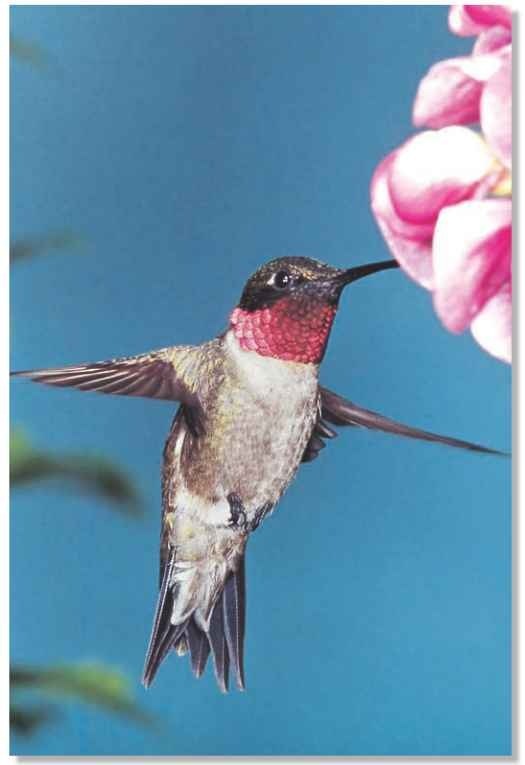ORDER
Apodiformes
FAMILY
Trochilidae
GENUS & SPECIES
KEY FEATURES
• A tiny bird with big performance, capable ‘. of astonishing feats of flight and endurance
• Able to hover and fly backward, sideways — and even upside down
Brilliant colors sparkle like jewels in the sun as it sips nectar from flowers
• Beats its wings at an incredibly fast rate to produce the “hum”
WHERE IN THE WORLD?
Migratory: breeds east of the Rocky Mountains in U. S. and southern Canada and flies south to spend the winter in warmer habitats in Mexico and Central America, as far south as Panama

Lifecycle
The ruby-throated hummingbird is adapted to an energetic existence. In its busy, buzzing quest for nectar, it may visit as many as 2,000 flowers in a day.
Habitat
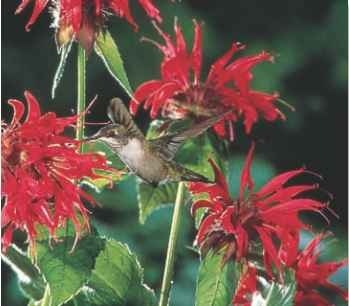
A Humming home Nectar-rich blooms attract the ruby-throat.
The ruby-throat is widespread across eastern North America, where it breeds. It is common in woodland glades of flowers, but
also occurs in parks and gardens, especially where bottles of sugar water have been hung to form hummingbird feeding stations.
The ruby-throat pauses in the U.S. on migration to refuel with nectar wherever it finds suitable flowers. Tropical forest in Mexico and Central America is its favorite winter habitat.
conservation
In the 19th century, thousands of hummingbirds were killed for European fashion trade and decorative stuffed specimens. Today, cagebird trade is in decline, but several species (including the ruby-throat) are still experiencing a slump in numbers. The reason is unclear, but may be connected with 1 destruction of the birds’ tropical winter habitats.
Behavior
The hummingbird’s ability to fly backward and hover in still air makes it unique among birds. It maintains control even when it rolls upside down in flight, which it does when fighting a rival. Male ruby-throats are aggressive to each other and will fearlessly attempt to chase off larger creatures, even eagles and humans.
The ruby-throat’s migration, a trip of up to 3,360 miles, is a marvel of nature. Some birds take the land route; others island-hop through the Caribbean. Many fuelled only by fat reserves, fly 480 miles nonstop across the Gulf of Mexico. Those that survive will have spent some 20 hours over water and made 4 million wing beats before their next sip of life-saving nectar.
flower power
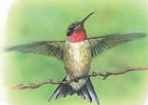
Countdown…
Like a helicopter revving rotor blades, the hummingbird whirs its wings in preparation for takeoff while still grasping its perch.
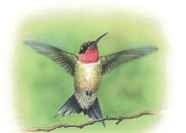
Lift-off…
Unlike other perching birds, which jump before using their wings, the hummingbird simply releases its grip on the branch, rising smoothly.
Food & feeding
The ruby-throat feeds mainly on nectar, sweet fluid of flowers that attracts pollinating insects and birds. Hovering above a bloom, the bird dips its bill into the flower’s throat and extends its tongue to sip. It also swoops into swarms of flies, catching them midair:
Because it burns energy so quickly the bird must feed every few minutes during the day. It can survive the night only by allowing its body temperature to drop and its heartbeat to slow down, until it enters deep torpor (inactive state).The next morning, it wakes with the sun, warms up, then flies off for another busy day feeding.
Mid-air refuelling The hummingbird feeds for only a few minutes at a time.
Color code The ruby-throat feeds from red or yellow flowers.
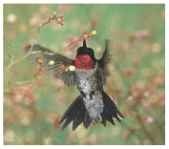
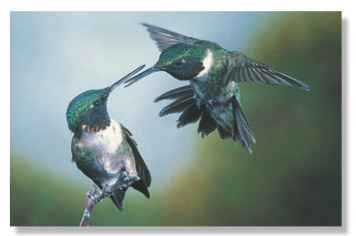
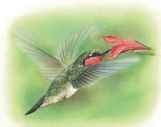
Hover…
By beating and swivelling its wings through a horizontal figure eight, the hummingbird achieves constant lift, allowing it to remain stationary.
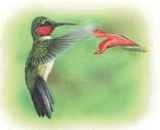
Reverse
After feeding, the bird reverses by pivoting its wings so their uppersides face downward. It then flies away from the flower.
Breeding
A male ruby-throat attracts a female by performing a display flight over his territory Like a tiny pendulum, he swings back and forth in a wide arc, wings beating faster than normal. After mating, the male goes to find another partner and plays no further part in family life.
The female alone builds the nest and incubates two minuscule eggs. The nest, about 1.6″ across, is a cup of plant down, bud scales and lichen, bound to a branch with spiders’ webs. The female feeds
her chicks small insects and regurgitated nectar by hovering over them and delicately putting her bill into theirs.
A dutiful parent
The female alone nurtures her chicks at the nest.
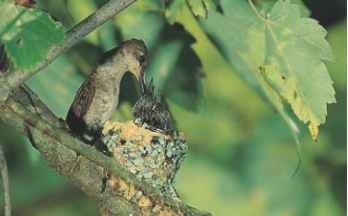
The hummingbird keeps clean by bathing in dewdrops on leaves or by taking a quick shower in a nearby waterfall.
The muscles that power the wings of the ruby-throat account for almost one-third its bodyweight.
Proportionate to body size, a hummingbird’s heart is one of the largest of any warm-blooded animal, beating an amazing 5001,200 times per minute. .

PROFILE
Ruby-throated Hummingbird
Hovering or accelerating vertically like a nectar-fueled rocket, the ruby-throat is a master of the air, aided by some unique features.
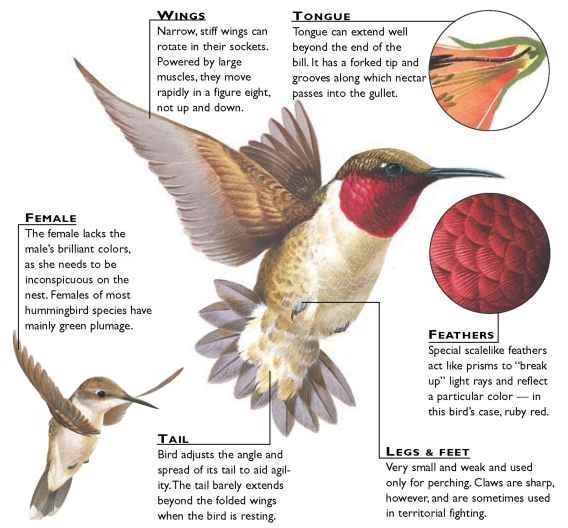
Creature comparisons
Hummingbirds have a variety of bill shapes designed for feeding from different flowers. The sword-billed has the longest bill, in proportion to body size, of any bird. The ruby-throat can reach into smaller blooms, while the white-tipped sicklebill can reach the nectar of flowers whose petals have a curved neck. By feeding from flowers in this way, hummingbirds are important pollinators of many flower species.
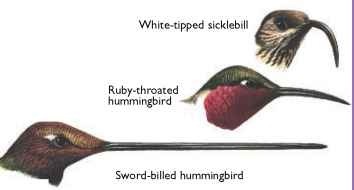
| VITAL | STATISTICS 0.19-0.24 oz. |
| Length | 3.6-3.8″ |
| WlNGSPAN | 4-4.8″ |
| Sexual Maturity | 1 year |
| Mating Season | Mainly May -June; from March in the south to July in the north |
| Number of Eggs | 2 |
| Incubation Period | 16 days |
| Fledging Period | 22-24 days |
| Number of Broods | 1-3 per year |
| Typical Diet | Nectar, insects and spiders |
| : Lifespan | 5 years in wild |
RELATED SPECIES
• The ruby-throat is one of more than 300 species found in the Americas, from Alaska to Tierra del Fuego. These include what is probably the world’s smallest bird, the 2″-long bee hummingbird (below), a rare species that is native to Cuba.
